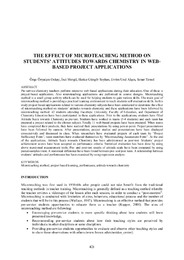The effect of microteaching method on Students’ attitudes towards chemistry in webbased Project applications

View/
Date
2007Author
Oskay, Ozge ÖzyalçınPublisher
University of CyprusPlace of publication
CY - ΛευκωσίαSource
CBLIS Conference Proceedings 2007 Contemporary Perspective on new technologies in science and educationGoogle Scholar check
Keyword(s):
Metadata
Show full item recordAbstract
Pre-service chemistry teachers perform intensive web-based applications during their education. One of these is project-based application. Also microteaching applications are performed in course designs. Microteaching method is a small group activity which can be used for helping students to gain various skills. The main goal of microteaching method is providing a practical learning environment to teach students self-evaluation skills. In this study project-based applications related to various chemistry subjects have been conducted to determine the effect of microteaching method on students’ attitudes towards chemistry and these applications have been followed by microteaching method. 42 students attending Hacettepe University, Faculty of Education, and Department of Chemistry Education have been participated in these applications. Prior to the applications, students have filled Attitude Scale towards Chemistry as pre-test. Students have worked in teams (3-4 students) and each team has prepared a project related to the chosen subject. Totally 11 web-based projects have been prepared. When teams have completed their products, they have realized their presentations by using power-point. Project presentations have been followed by camera. After presentations, project studies and presentations have been displayed consecutively and discussed in class. When researchers have evaluated projects of each team by “Project Sufficiency Form”, team members have evaluated themselves by “Microteaching Assessment Form”. At the end of the applications, Attitude Scale towards Chemistry has been administered as post-test. Students’ project
achievement scores have been accepted as performance criteria. Statistical evaluation has been done by using above mentioned measurement tools. Pre- and post-test results of attitude scale have been compared by using paired-samples t-test. A statistical difference have been found between pre- and post tests. A relationship between students’ attitudes and performance has been examined by using regression analyze.
